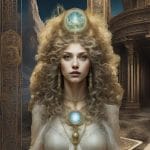The hidden archetypes of Tarot are not psychological projections of the collective unconscious, but independent symbolic currents that shape the psyche. Jung merely rediscovered what the Tarot had been transmitting for centuries.

How Ancient Hidden Archetypes Shaped Psychology, Not the Other Way Around
Have you ever had a dream that felt bigger than just your own thoughts?
While many modern seekers assume that the Tarot’s hidden archetypes merely mirror Jung’s theory of the collective unconscious, the opposite perspective may be closer to the truth.
The Tarot does not borrow its understanding from psychology; rather, psychology unconsciously echoes the timeless wisdom already embedded within the Tarot.
Jung may have given names and frameworks to archetypal forces, but the Tarot had been mapping these living symbols for centuries, transmitting them through images, numbers, and myths. Instead of viewing the cards as projections of the human mind, we might recognize them as independent symbolic currents that actively shape the psyche — currents that the Tarot preserved long before psychology attempted to explain them.
This isn’t about magic or fantasy; it’s about psychology, the science of the Human mind. All of this connects to a fascinating idea from the famous psychologist Carl Jung.
Let’s explore how the hidden patterns in Tarot cards connect to what Jung called the collective unconscious and its archetypes.

What Is the “Collective Unconscious”?
Imagine your mind is like an iceberg. The tip above the water is your conscious mind, what you’re thinking about right now. Just below the surface is your personal unconscious, filled with your private memories and things you’ve forgotten.
But Carl Jung believed the iceberg goes much, much deeper. He said that at the very bottom, we all share a common foundation: the collective unconscious. Think of it as a shared psychological Wi-Fi network that all humans are connected to. It doesn’t hold your personal memories, but instead, it contains universal patterns and potentials that every person is born with. It’s why stories from different cultures often have similar themes, like a great flood or a heroic journey. We’re all tapping into the same source.
Meet the Hidden Archetypes: The Characters of the Human Story
So, what’s inside this collective unconscious? Jung called the contents archetypes.
Archetypes aren’t ready-made images; they’re more like invisible molds or blueprints. They are the basic character types and themes of the human story. For example:
The Hero: The part of us that faces challenges and fights for what’s right.
The Caregiver: The nurturing, protective instinct we all possess.
The Trickster:The rule-breaker who brings chaos and change.
The Shadow: The hidden part of ourselves that contains the things we repress or fear.
We see these archetypes everywhere, in myths, fairy tales, and especially in the movies and books we love.
The Tarot Deck: The Book of Hidden Archetypes
This is where the Tarot deck comes in. A Tarot deck has 78 cards, but the most important ones for this idea are the 22 cards of the Major Arcana. These aren’t cards about everyday things like “a surprise message” or “a financial opportunity.” They have names like The Fool, The Magician, The Empress, The Hermit, and The World.
Think of the Major Arcana as a picture book of Jung’s archetypes. Each card is a powerful, symbolic illustration of a universal human experience.
The Fool is the archetype of beginnings, the innocent soul setting off on the adventure of life.
The High Priestess is the archetype of intuition and hidden knowledge.
The Emperor represents structure, order, and authority.
The Devil can symbolize the Shadow, the temptations, and the negative patterns we feel chained to.
The Star is the archetype of hope and inspiration after a dark time.
When you look at these cards, you’re not just seeing pretty pictures. You’re looking at mirrors reflecting the fundamental characters and stages of your own inner world.
The Fool’s Journey: The Map to Becoming Yourself
The most beautiful connection is the story the Major Arcana tells. It’s often called “The Fool’s Journey.” The Fool (card 0) starts as a blank slate, full of potential but with no experience. As the story progresses, he meets each archetype: The Magician, The Empress, The Lovers, Death, The Tower, and so on, facing the lessons they represent.
This journey is a perfect map for what Carl Jung used to call the Human Journey towards individuation, the lifelong process of becoming your true, complete self. It’s about facing your “Shadow,” listening to your intuition, overcoming challenges, and integrating all these parts of yourself. The journey ends with The World (card 21), which represents wholeness, fulfillment, and understanding how you fit into the bigger picture.
So, What’s the Real Magic?
When people use Tarot cards for self-discovery instead of fortune-telling, they are using them as a psychological tool. By laying out the cards and asking, “What energy is present in my life right now?” they are starting a conversation with their own unconscious mind.
The card you draw might resonate because it reflects an archetype you are currently dealing with. Maybe you’re needing the courage of The Chariot to overcome a conflict, or the patience of The Hermit to find answers within.
In conclusion, the magic isn’t in the cards predicting your future. The magic is in their ability to tap into the collective unconscious and help you understand your own story better.
About the Authors
Liane and Christopher Buck are the creators of the Tao of Tarot, whose first book and card set is The Hidden Arcana Tarot. They are also the founders of OMTimes Magazine, Humanity Healing Network, and the charities Humanity Healing International and Cathedral of the Soul. Read more on their Bio Page.

Facebook | YouTube | X | Instagram | TikTok | Medium | BlueSky | Pinterest

